Croton Plant: Care and Growing Guide of Codiaeum Variegatum (With Pictures)

Croton plants (Codiaeum variegatum) are evergreen tropical flowering plants with stunningly colorful red, green and yellow patterned leaves. Many varieties of croton plants, such as the Croton ‘Petra’, are popular houseplants that thrive in sunny conditions in average room temperatures. Generally, croton plants are easy to grow indoors.
Grow croton plants indoors by placing them in bright indirect light and planting them in a well-draining potting mix. Colorful croton plants thrive in room temperatures between 60°F and 70°F (16° – 21°C). Croton plants can drop leaves if they grow in cold drafts. Mist the foliage frequently and keep the soil moist in summer.
What is a Croton Plant?

Croton plants include many cultivars with beautiful colorful foliage
Croton plants are perennial evergreen cultivars in the tropical plant genus Codiaeum. Although Croton species produce small flowers, it’s their colorful foliage that makes them prized houseplants. The hues of red, yellow, orange, and violet give each croton plant a unique appearance.
An identifying feature of croton plants is their thick leathery leaves. Apart from having spectacular colors, different cultivars have different shapes of leaves. The leaf blades with patterned veins can be lanceolate, egg-shaped, violin-shaped, oblong, or thin and long. One croton plant can have multicolored leaves, giving the plant a fiery look.
There are over 100 varieties of croton plants. Other names for these cool and unusual houseplants include fire croton, variegated croton, and garden croton.
Crotons plants are large shrubs that grow up to 10 ft. (3 m) tall outdoors in tropical gardens. The slow-growing pot plants have a growth rate of about 12” (30 cm) per season. Mature croton plants have a rounded growth with a spread of 6 ft. (1.8 m). Due to their dense bushy foliage, croton shrubs make for colorful garden privacy hedges or specimen plants if grown outdoors in USDA zones 10 – 11.
Potted croton houseplants typically don’t grow taller than 3 ft. (1 m) indoors. As long as you get their care right, croton plants will grow vibrantly colored, bushy foliage for many years.
What is Croton Petra?
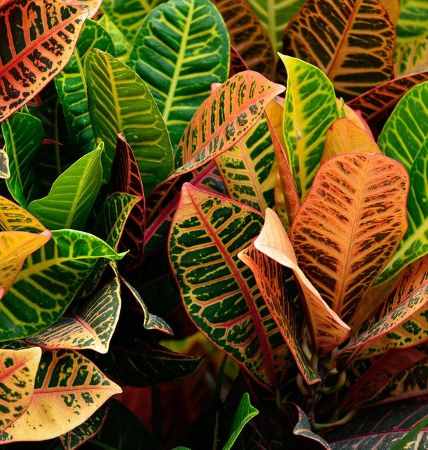
Croton petra is a common houseplant with stunning colorful leaves
Croton ‘Petra’ (Codiaeum variegatum ‘Petra’) is a stunning houseplant with large, leathery leaves. The ‘Petra’ cultivar has spectacular variegated foliage color. The large glossy leaves have pronounced colorful veins. The ovate-shaped leaves with pointed tips can be green and yellow, green and orange, or green and red.
Croton ‘Petra’ plant care
Croton ‘Petra’ cultivars thrive where they get six to eight hours of indirect sunlight. To ensure healthy growth, grow in slightly moist soil, water the ‘Petra’ croton whenever the potting soil dries, and mist the plants weekly. Fertilizing in spring and summer encourages robust growth and vibrant bushy foliage.
As with most croton plants, it’s vital to make sure that you keep the Croton ‘Petra’ plant away from drafts or cold temperatures.
Croton Plant Flowers
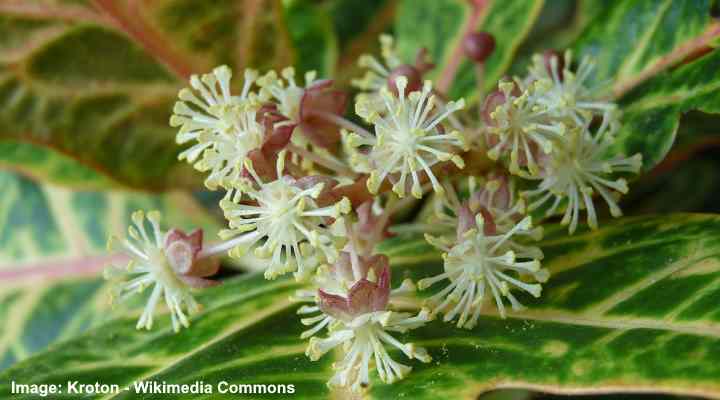
Croton male flowers are creamy white and star-like and are produced on long inflorescences
All species of crotons produce tiny star-shaped flowers on long thin stems when grown outdoors. However croton plants rarely flower when grown as indoor plants. The insignificant flower clusters can be hard to spot in among the glossy, leafy foliage. Of course, people keep potted croton plants for their leathery, shiny leaves, and not for their tiny clusters of flowers.
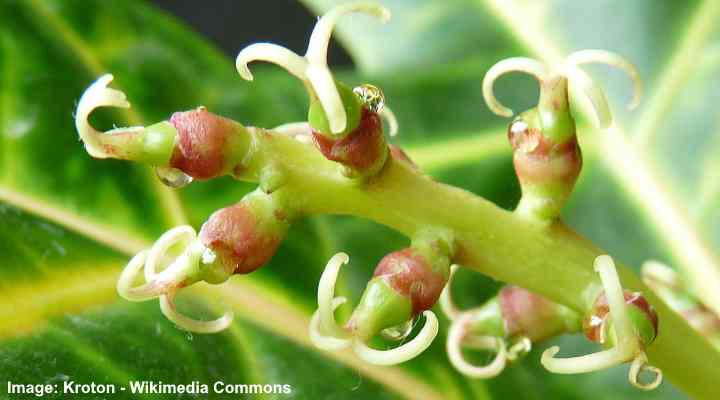
Croton female flowers don’t have petals and when fertilized they produce round fruits
Why Are Croton Plants Popular?
Croton plants are popular houseplants due to their spectacular colorful glossy leaves. Croton plants can add color to any bright room in your house without flowering. Because these tropical plants are evergreen, you enjoy their vivid, multicolored foliage all year long.
If you live in USDA zones 10 and 11, croton shrubs are an excellent choice to brighten up a garden landscape.
What Are the Different Croton Plant Varieties?
All varieties of Codiaeum variegatum have bright bushy foliage.
Here are different croton plant varieties:
Croton Mammy. A bold houseplant with multicolored, elongated variegated leaves with twisted growth and wavy edges.
Gold Dust Croton. This croton plant has oblong, shiny green leaves with bright yellow splotches and dots that look like they’ve been dusted with gold powder.
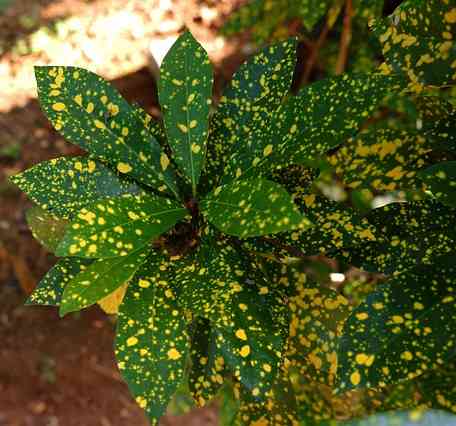
Gold dust croton
Croton Magnificent. The broad wavy leaves of this croton have dark green and bright yellow variegation. Some of these ‘magnificent’ crotons have orange or burgundy colors on the green leaves.
Bush on Fire Croton. The long, pointed croton leaves have green, yellow, orange and red variegation.
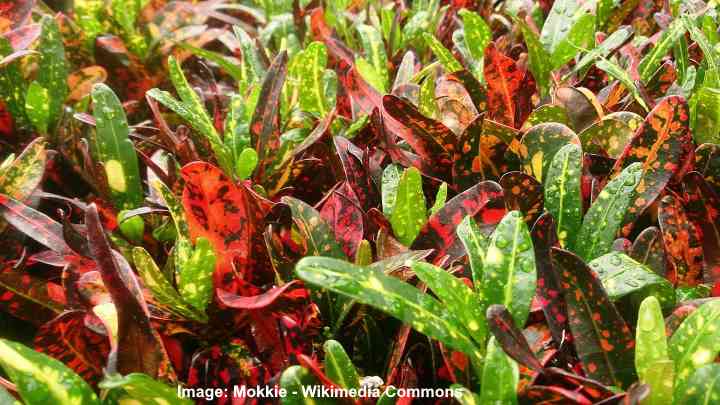
Bush on Fire Croton
Banana Croton. This small compact croton plant has banana-shaped leaves with bright banana-yellow and green coloring.
Croton Plant Care
Croton plants are relatively easy to grow indoors if you get the lighting, watering, and temperature conditions right. To care for croton plants avoid temperature extremes, keep the soil moist but not too damp, and regularly mist the leaves. If you get these care factors right, you’ll prevent croton plant leaves from dropping.
Here is how to grow and care for croton.
Light Requirements for Growing Croton Plants Indoors
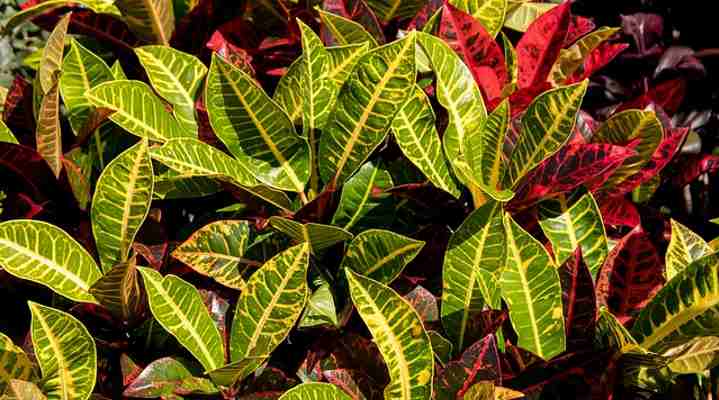
To care properly for your croton plants, place them in a bright location protected from direct sunlight
Croton plants love plenty of indirect sunlight to grow well. Ideally, varieties of crotons should get between six and eight hours of sunlight daily. It’s best to protect the plants from too much direct sunlight. However, bright indirect light keeps the colors vibrant on the stunning foliage.
The best location for a potted croton plant is near a south- or west-facing window. You’ll find that the spectacular leaf colors will fade and look washed-out if there’s not enough sunlight. However, croton plants that get too much direct sunlight may also experience fading foliage colors.
How Often to Water Croton Plants
Water croton plants as often as the top layer of soil dries out. Every week during spring and summer, test the potting soil for dryness. If the top 0.5” (1.2 cm) is dry, then it’s a sign you need to water the moisture-loving plant. If the top of the soil still feels damp, hold off watering until the soil is drier.
Croton plants are from tropical, humid climates. Therefore, the soil should be constantly moist. However, too much dampness in the potting soil will cause the roots to rot. But crotons are not drought-tolerant plants. So, the soil can never be too dry; otherwise, the spectacular foliage will start to wilt.
Remember that croton plants love plenty of water. To avoid overwatering, only water when the top of the soil feels dry. Frequent watering keeps the soil moist, and letting the soil dry slightly prevents the roots from becoming waterlogged.
Related reading: Top tips to water your houseplants properly.
The Best Kind of Soil for Croton Houseplants
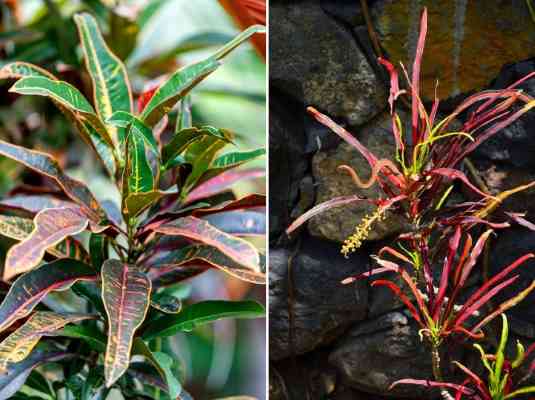
Grow croton houseplants in a well-draining potting mix
Croton plants thrive in a fertile potting mix that has excellent drainage. A combination of regular houseplant soil, peat moss, and perlite creates the ideal soil mix for healthy croton plants. This type of potting soil allows excess water to drain quickly but holds enough moisture to keep the roots moist.
The worst thing for croton plants is if they sit in waterlogged soil.
Here are a few handy tips on making sure that the potting mix provides the ideal growing conditions for these tropical plants:
- Only grow croton plants in pots that have drainage holes in the base.
- Make sure that the soil is light and loose to allow water to drain fast.
- Repot croton plants if they become rootbound.
- Amend the potting mix with perlite and peat moss if water starts to pool on the surface.
What Temperature Does Croton Indoor Plants Grow Best?
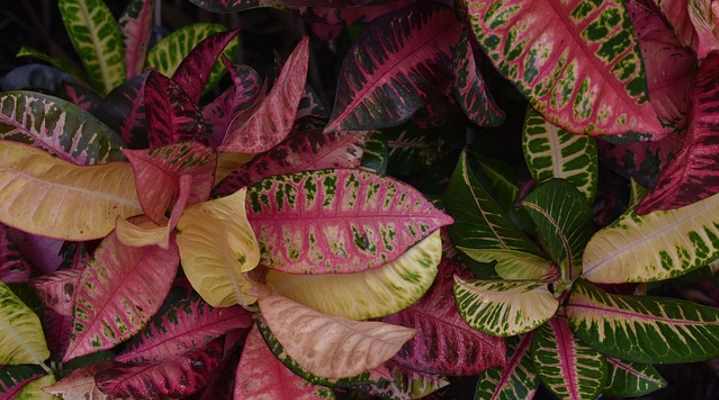
Being a tropical plant, it’s very important to keep croton plants away from cold drafts
Croton plants thrive in a temperature range of 60°F and 70°F (16° – 21°C). The maximum temperature for crotons is 80°F (26°C), and the minimum temperature is 55°F (12°C). Generally, croton plants grow well in average room temperatures if they get enough sunlight. It’s vital to keep the tropical plants away from chilly drafts.
Croton shrubs grow in front or backyards if you live in USDA zones 10 or 11. In some inland areas, away from sea breezes, you can also grow croton plants in zone 9. But you need to protect the heat-loving plant from wind and temperatures below 55°F (12°C).
In temperate climates, you can take potted croton plants outdoors during the summer. Place the plant pot in a sheltered, sunny location. These bushy foliage plants add plenty of warm colors to your balcony, patio, or deck area. Leaf drop is a sign that cold drafts are affecting your tropical potted houseplant.
It’s good to remember that drafts from open doors, windows, or the air-conditioning can chill croton houseplants. Also, hot air from air ducts can affect croton plant growth.
Humidity Requirements for Growing Croton Plants Indoors
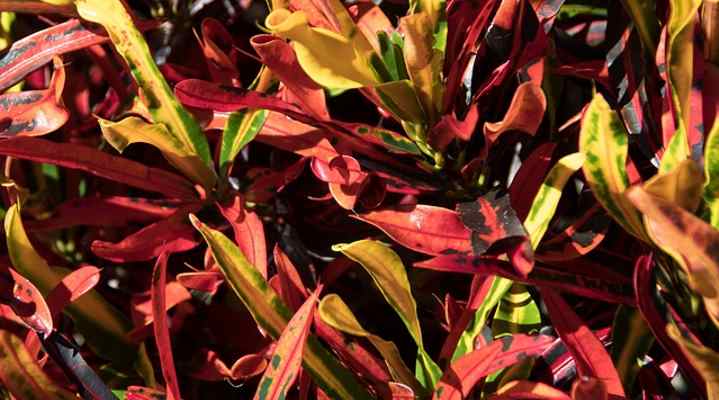
Croton plants require misting once or twice a week to maintain proper humidity
Being a variety of tropical plant, croton houseplants need at least 40 percent humidity. Because household air tends to be too dry—especially when the heating is on—getting air moisture levels right is tricky. Usually, you’ll need to mist leaves once or twice a week to maintain the proper humidity.
Here are a few handy tips to boost humidity for your beautiful croton plant:
- Wipe the leaves weekly with a damp cloth to moisturize them and remove dust.
- Mist leaves twice a week with filtered water at room temperature.
- Place your potted croton plant on a tray of pebbles and pour water into the tray so it’s half full.
- Use a room humidifier to keep humidity at least 40 percent.
- Group your houseplants to create a more humid environment.
A sign that your colorful croton plant is lacking moisture includes leaf drop.
How to Propagate a Croton Plant
Croton plant propagation is best done with stem cuttings from a healthy plant. When propagating stem cuttings, the cut stem emits a milky, white sap. This irritant can cause dermatitis in humans. So, always wear protective gloves when cutting croton stems.
To propagate a croton plant, cut a stem 3” to 4” (7.5 – 10 cm) long that has at least three leaves. Lay the croton cutting on a paper towel for a couple of days to allow the ‘wound’ to heal. Plant the stem cutting in a loose potting mix.
To help your propagated cutting take root, place the potted cutting in a bright location, cover the cutting with a plastic bag to create a humid, warm environment, and ensure the soil is moist. After a few weeks, the plant should have roots, and you can care for the croton plant as usual.
How to Prune a Croton Houseplant
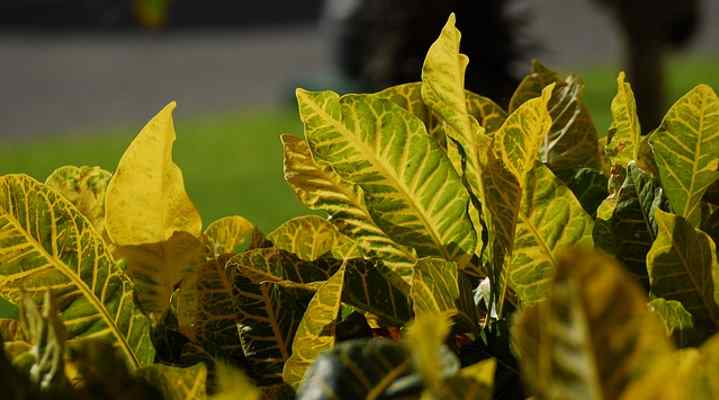
You can prune croton plant to control its height or to encourage bushier appearance
Prune croton plants to remove leggy growth or dead leaves. Croton plants naturally have dense, bushy foliage, so pruning isn’t always necessary to encourage more growth. To remove dead leaves, cut the leaf stem where it joins the plant. If you want to remove leggy stems, trim them just above a node.
Croton houseplants can grow to between 6 and 10 ft. (1.8 – 3 m) tall. So, pruning the plant can help manage its height. All you need to do is cut the main stem at the size you desire. Trimming the plant also helps to make the foliage even bushier.
Remember to protect your hands with gloves when pruning croton leaves or stems to prevent the white sap from irritating your skin.
Repotting Croton Plants
If the croton plant has become rootbound, repot it in spring. Always choose a container one size larger than its current one. All you need to do is remove the leafy plant from the existing container and shake off any loose dirt. Place in a new container, fill with the appropriate potting mix and make sure the plant is growing at the same height as before. Thoroughly water the plant.
Are Croton Plants Poisonous?
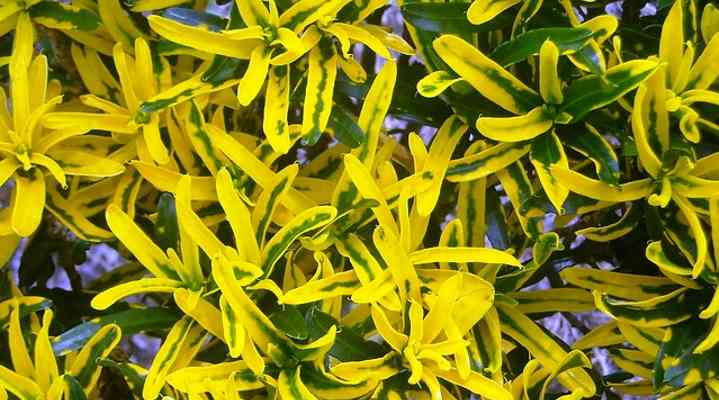
Croton plants are toxic to humans and pets
All parts of croton (Codiaeum variegatum) are poisonous. Croton stems and leaves contain a milky latex sap that can be toxic to cats and dogs. The white liquid can cause irritation when it comes into contact with the skin. This could cause excessive drooling or oral pain in pets. However, researchers from NC State Extension say that the plant is only dangerous if consumed in large quantities.
Pests Affect Croton Plant Growth
It’s crucial to get rid of pests from a croton plant leaves or stems fast. Mix 2 tsp. neem oil and 1. tsp dish soap with 1 quart of warm water in a spray bottle. Liberally spray both sides of the croton plant’s leaves every week to get rid of the pests.
You can also use a cotton pad soaked in rubbing alcohol to kill off plant pests on contact.
Healthy croton plants are generally resistant to pest infestations. However, mealybugs, thrips, scale insects, or spider mites can affect your plant’s growth. These houseplant pests suck the sap from plants, eventually weakening their growth.
Related reading: How to identify the most common houseplant pests.
Diseases Affecting Croton Houseplants
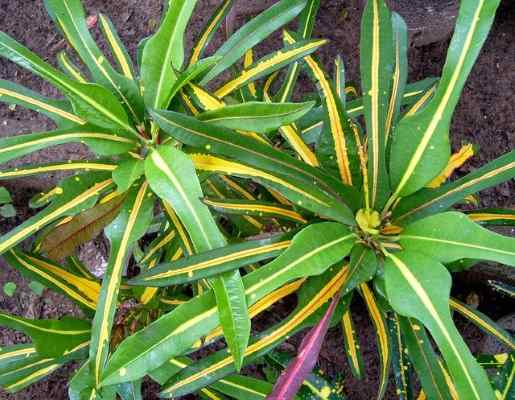
Croton plant dropping its leaves is usually a sign of root rot
Root rot is the most common disease to affect croton plant growth. You can easily prevent roots from rotting by watering your tropical houseplant correctly. Overly damp or waterlogged soil causes the plant’s root system to decay and die. The first sign of root rot is usually leaves that drop from the plant.
Top croton plant care tip: Try to keep the croton plant’s growing medium moist without it being too soggy to avoid fungal and bacterial diseases.
Croton Plant Care: FAQs
Although croton plants are relatively easy to grow, they can be temperamental if conditions aren’t right. Here are the answers to a few questions about successfully caring for croton plants indoors.
Why is my croton plant dropping its leaves?
Watering issues and cold drafts are usually to blame for croton leaves falling off. Overwatering croton plants results in root rot. Because of this, the plant can’t get enough nutrients. The result is that the croton leaves start drooping before falling off. On the other hand, dry soil will also cause leaves to drop as the moisture-loving plant becomes dehydrated.
But suppose you are watering the croton plant correctly and leaves are still dropping. In that case, make sure the plant isn’t in direct sunlight for too long or standing in cold drafts.
How can I revive a dying croton plant?
You can bring a dying croton plant back to life if you resolve the underlying care issue. Croton plants are reasonably hardy. Even if many leaves have fallen off, you can still revive the plant by repotting it in a fresh potting mix, adjusting your watering schedule, or changing its position.
Where to grow croton plants in winter
The best place to grow croton plants during winter is near a south-facing window. Croton plants don’t become dormant in winter and still need some care. So, you should make sure they get enough sunlight—at least two or three hours a day. Also, water the plants occasionally when the top 1” to 2” (2.5 cm – 5 cm) of soil is dry.
You’ll have to keep humidity levels high in winter because household heating can make the air too dry for croton plants.
Related articles:
